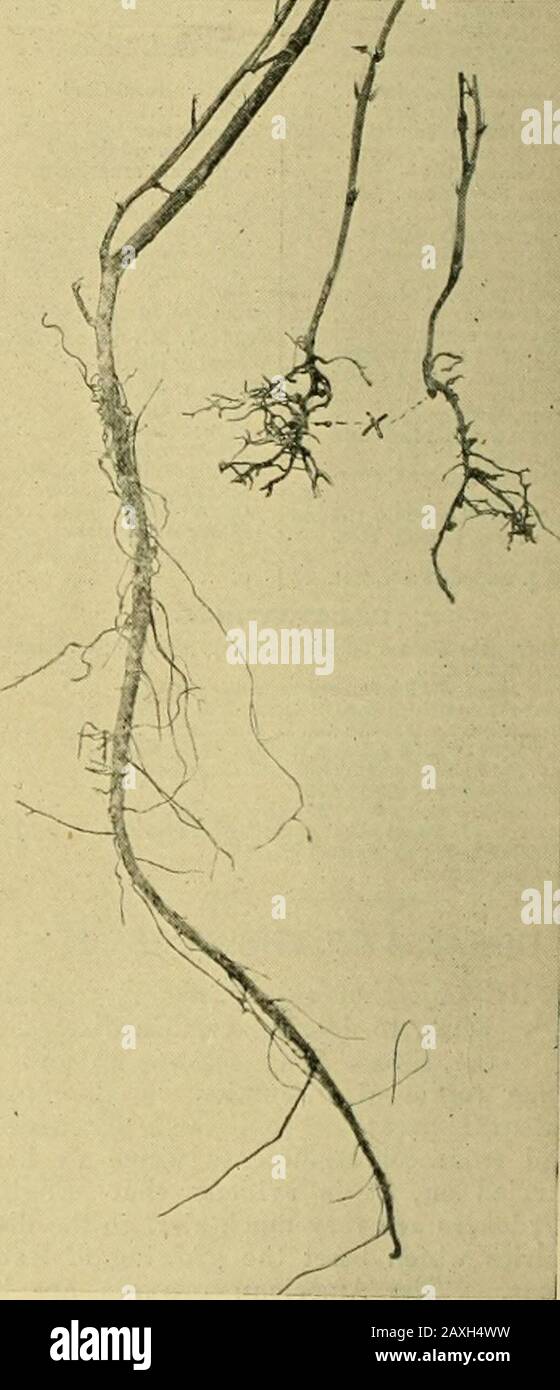The Gardeners' chronicle : a weekly illustrated journal of horticulture and allied subjects . Root Rot Caused bt Rhizoctonia. This fungous disease is common tomany seedlings, namely, Lettuce, Tomato,Tobacco, Pea and others. Like the culi-nary Pea, the Sweet Pea in its early stagesis also subject to the disease. The fungusis known as Rhizoctonia and also Corticumvagum. Severely infected plants have practicallyno root system (see fig. 12 b). In less in-fected plants only one or two rootlets maybe destroyed. By the layman this diseasemay be confused with the stem rot, a de-scription of which foll

Image details
Contributor:
The Reading Room / Alamy Stock PhotoImage ID:
2AXH4WWFile size:
7.1 MB (257.9 KB Compressed download)Releases:
Model - no | Property - noDo I need a release?Dimensions:
1038 x 2407 px | 17.6 x 40.8 cm | 6.9 x 16 inches | 150dpiMore information:
This image is a public domain image, which means either that copyright has expired in the image or the copyright holder has waived their copyright. Alamy charges you a fee for access to the high resolution copy of the image.
This image could have imperfections as it’s either historical or reportage.
The Gardeners' chronicle : a weekly illustrated journal of horticulture and allied subjects . Root Rot Caused bt Rhizoctonia. This fungous disease is common tomany seedlings, namely, Lettuce, Tomato, Tobacco, Pea and others. Like the culi-nary Pea, the Sweet Pea in its early stagesis also subject to the disease. The fungusis known as Rhizoctonia and also Corticumvagum. Severely infected plants have practicallyno root system (see fig. 12 b). In less in-fected plants only one or two rootlets maybe destroyed. By the layman this diseasemay be confused with the stem rot, a de-scription of which follows. It differs fromthe latter in its browning effects on the. Fig. 11.—root rot caused by thielavia. comparing root systems of healthy plant with diseased plants same age. Fig. 10.—root rot caused by thielavia.contrasting healthy with diseased plant same age. well in mind—that is, he described it as astem disease. The Thielavia disease, asalready mentioned, is not a stem but aroot disease. Chittenden seemed to have been unableto infect healthy Sweet Pea seedlings withthe fungus Thielavia basicola under nor-mal conditions of growth. It was onlywhen his plants were subjected to over-watering that the fungus became an activeparasite. In our own inoculation experiments, tobacco and trucking districts in theUnited States. Undoubtedly this fungusis common in the gardens of GreatBritain, which explains its occurrence onthe roots of plants attacked by Streak.Plants infected with Thielavia basicolado not quickly die; they may linger for along time, or indeed sometimes throughoutthe entire growing season. However, such infected plants remain very dwa